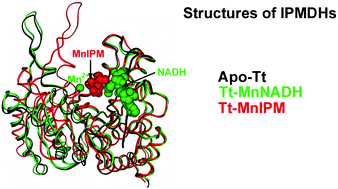Atomic level description of the domain closure in a dimeric enzyme: Thermus thermophilus3-isopropylmalate dehydrogenase
Abstract
The domain closure associated with the

Maintenance work is planned for Wednesday 1st May 2024 from 9:00am to 11:00am (BST).
During this time, the performance of our website may be affected - searches may run slowly and some pages may be temporarily unavailable. If this happens, please try refreshing your web browser or try waiting two to three minutes before trying again.
We apologise for any inconvenience this might cause and thank you for your patience.
* Corresponding authors
a
Institute of Enzymology, Biological Research Center, Hungarian Academy of Sciences, P.O. Box 7, H1518 Budapest, Hungary
E-mail:
vas@enzim.hu
Fax: +36-1-466-5465
Tel: +36-1-279-3152
b University of Parma, Department of Biochemistry and Molecular Biology, Viale G.P. Usberti 23/A, 43100 Parma, Italy
c National Chemical Laboratory, Dr Homi Bhabha Road, Pune–411008, India
d Leiden University Medical Center, Molecular Cell Biology, Electron Microscopy Section, P.O. Box 9600, Leiden, The Netherlands
e Helmholtz-Zentrum Berlin für Materialien und Energie, Macromolecular Crystallography (BESSY-MX), Albert-Einstein-Str. 15, D-12489 Berlin, Germany
The domain closure associated with the

 Please wait while we load your content...
Something went wrong. Try again?
Please wait while we load your content...
Something went wrong. Try again?
É. Gráczer, A. Merli, R. K. Singh, M. Karuppasamy, P. Závodszky, M. S. Weiss and M. Vas, Mol. BioSyst., 2011, 7, 1646 DOI: 10.1039/C0MB00346H
To request permission to reproduce material from this article, please go to the Copyright Clearance Center request page.
If you are an author contributing to an RSC publication, you do not need to request permission provided correct acknowledgement is given.
If you are the author of this article, you do not need to request permission to reproduce figures and diagrams provided correct acknowledgement is given. If you want to reproduce the whole article in a third-party publication (excluding your thesis/dissertation for which permission is not required) please go to the Copyright Clearance Center request page.
Read more about how to correctly acknowledge RSC content.
 Fetching data from CrossRef.
Fetching data from CrossRef.
This may take some time to load.
Loading related content
